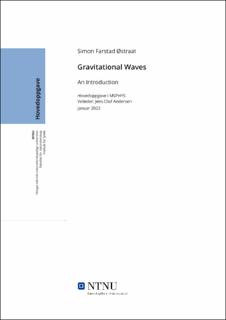| dc.contributor.advisor | Andersen, Jens Oluf | |
| dc.contributor.author | Østraat, Simon Farstad | |
| dc.date.accessioned | 2022-11-12T18:20:06Z | |
| dc.date.available | 2022-11-12T18:20:06Z | |
| dc.date.issued | 2022 | |
| dc.identifier | no.ntnu:inspera:108350165:30697543 | |
| dc.identifier.uri | https://hdl.handle.net/11250/3031528 | |
| dc.description.abstract | I denne oppgaven vil vi først se den svake feltgrensen til Einsteins feltligninger og den grunnleggende formalismen for gravitasjonelle bølger i den lineariserte teorien. Videre vil vi ta et skritt utenfor den lineariserte teorien for å kunne finne spennings-energitensoren til forplantende bølger. Deretter vurderer vi ikke-relativistiske binære systemer til momentet av laveste orden, kvadrupolmomentet, og finner kraften og amplituden til strålingen som systemet sender ut. Til slutt vurderer vi hvordan eksperimenter som LIGO er i stand til å oppdage gravitasjonelle bølger til tross for deres ekstremt små amplituder. | |
| dc.description.abstract | In this thesis we will first the weak field limit of Einsteins field equations and the basic formalism for GWs in the linearised theory. Further we will take a step outside the linearised theory in order to able to find the stress-energy tensor of propagating waves. Next we consider non-relativistic binary systems to the lowest order moment, the quadrupole moment, and find the power and amplitude of the radiation which the system emits. Lastly we consider how experiments such as LIGO is able to detect the GW despite their extremely small amplitude. | |
| dc.language | eng | |
| dc.publisher | NTNU | |
| dc.title | Gravitational waves | |
| dc.type | Master thesis | |
